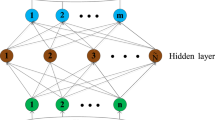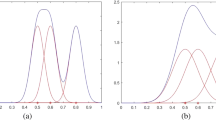Abstract
In this work, an Incremental Learning Algorithm via Dynamically Weighting Ensemble Learning (DWE-IL) is proposed to solve the problem of Non-Stationary Time Series Prediction (NS-TSP). The basic principle of DWE-IL is to track real-time data changes by dynamically establishing and maintaining a knowledge base composed of multiple basic models. It trains the base model for each non-stationary time series subset, and finally combine each base model with dynamically weighting rules. The emphasis of the DWE-IL algorithm lies in the update of data weights and base model weights and the training of the base model. Finally, the experimental results of the DWE-IL algorithm on six non-stationary time series datasets are presented and compared with those of several other excellent algorithms. It can be concluded from the experimental results that the DWE-IL algorithm provides a good solution to the challenges of the NS-TSP tasks and has significantly superior performance over other comparative algorithms.










Similar content being viewed by others
Explore related subjects
Discover the latest articles, news and stories from top researchers in related subjects.References
Box GE, Jenkins GM, Reinsel GC, Ljung GM (2016) Time series analysis: forecasting and control. J Time Ser Anal 37:709–711
Garcia R et al (2005) A GARCH forecasting model to predict day-ahead electricity prices. IEEE Trans Power Syst 20(2):867–874
Cao J, Li Z, Li J (2019) Financial time series forecasting model based on CEEMDAN and LSTM. Physica A: Statistic Mech Appl 519:127–139
Silva Jr. CAS et al (2020) Forecasting in Non-stationary Environments with Fuzzy Time Series, Appl Soft Comput, 97
Cao L, Gu Q (2002) Dynamic support vector machines for non-stationary time series forecasting. Intell Data Anal 6(1):67–83
Gu B et al (2015) Incremental learning for ν -Support Vector Regression. Neural Netw 67:140–150
Webb GI, Zheng Z (2004) Multistrategy ensemble learning: reducing error by combining ensemble learning techniques. IEEE Trans Knowl Data Eng 16(8):980–991
Van Heeswijk M, Miche Y, Lindh-Knuutila T, Hilbers PA, Honkela T, Oja E, Lendasse A (2009) Adaptive ensemble models of extreme learning machines for time series prediction, in Proceedings of the 19th International Conference on Artifical Neural Networks, 305–314
Chacón HD, Kesici E, Najafirad P (2020) Improving financial time series prediction accuracy using ensemble empirical mode decomposition and recurrent neural networks. IEEE Access 8:117133–117145
Yan B, Aasma M (2020) A novel deep learning framework: prediction and analysis of financial time series using CEEMD and LSTM. Expert Syst Appl 159:113609
Cavalcante RC, Oliveira ALI (2015) An approach to handle concept drift in financial time series based on Extreme Learning Machines and explicit Drift Detection, in 2015 International Joint Conference on Neural Networks (IJCNN), 1–8
Makili L, Vega J, Dormido-Canto S (2013) Incremental support vector machines for fast reliable image recognition. Fusion Eng Design 88(6–8):1170–1173
Fu J, Lee S (2012) A multi-class SVM classification system based on learning methods from indistinguishable chinese official documents. Expert Syst Appl 39(3):3127–3134
Yi Y, Wu J, Xu W (2011) Incremental SVM based on reserved set for network intrusion detection. Expert Syst Appl 38(6):7698–7707
Chitrakar R, Huang C (2014) Selection of candidate support vectors in incremental SVM for network intrusion detection. Comput Secur 45:231–241
Giraud-Carrier C (2000) A note on the utility of incremental learning. Ai Commun 13(4):215–223
Drucker H (1997) Improving regressors using boosting techniques, in Proceedings of Fourteenth International Conference on Machine Learning (ICML)
Zhang C-X, Zhang J-S, Ji N-N, Guo G (2014) Learning ensemble classifiers via restricted Boltzmann machines. Pattern Recogn Lett 36:161–170
De-la-Torre M, Granger E, Sabourin R, Gorodnichy DO (2015) Adaptive skew-sensitive ensembles for face recognition in video surveillance. Pattern Recogn 48(11):3385–3406
Dai K, Zhao J, Cao F (2015) A novel decorrelated neural network ensemble algorithm for face recognition. Knowl-Based Syst 89:541–552
Williams TP, Gong J (2014) Predicting construction cost overruns using text mining, numerical data and ensemble classifiers. Autom Constr 43:23–29
Zhang Y, Zhang L, Neoh SC, Mistry K, Hossain MA (2015) Intelligent affect regression for bodily expressions using hybrid particle swarm optimization and adaptive ensembles. Expert Syst Appl 42(22):8678–8697
Blum A (1997) Empirical support for winnow and weighted-majority algorithms: results on a calendar scheduling domain. Mach Learn 26(1):5–23
Oza NC, Russell S (2000) Online ensemble learning, in Proceedings of the Seventeenth National Conference on Artificial Intelligence and Twelfth Conference on Innovative Applications of Artificial Intelligence, pp. 1109
Nishida K, Yamauchi K, Omori T (2005) ACE: adaptive classifiers-ensemble system for concept-drifting environments. Lect Notes Comput Sci 3541:176–185
Street WN, Kim Y (2001) A streaming ensemble algorithm (SEA) for large-scale classification," in Proceedings of the Seventh ACM SIGKDD Internaional Conference on Knowledge Discovery and Data Mining, 377–382
Chen Y, Song S, Li S, Yang L, Wu C (2018) Domain space transfer extreme learning machine for domain adaptation. IEEE Trans Cybern 49(5):1909–1922
Huang G-B, Zhou H, Ding X, Zhang R (2011) Extreme learning machine for regression and multiclass classification. IEEE Trans Syst Man Cybern, Part B (Cybern) 42(2):513–529
Belciug S, Gorunescu F (Jul, 2018) Learning a single-hidden layer feedforward neural network using a rank correlation-based strategy with application to high dimensional gene expression and proteomic spectra datasets in cancer detection. J Biomed Inform 83:159–166
Huang GB, Zhu QY, Siew CK (Dec, 2006) Extreme learning machine: theory and applications. Neurocomputing 70(1–3):489–501
Grigorievskiy A, Miche Y, Ventela AM, Severin E, Lendasse A (Mar, 2014) Long-term time series prediction using OP-ELM. Neural Netw 51:50–56
Feng GR, Huang GB, Lin QP, Gay R (Aug, 2009) Error minimized extreme learning machine with growth of hidden nodes and incremental learning. IEEE Trans Neural Netw 20(8):1352–1357
Yahoo Finance[EB/OL]. Available: https://finance.yahoo.com/
Chandra R, Zhang MJ (2012) Cooperative coevolution of Elman recurrent neural networks for chaotic time series prediction. Neurocomput 86:116–123
Phillips PCB, Ouliaris S (1990) Asymptotic properties of residual based tests for cointegration. Econometrica 58(1):165–193
Minowa Y (Oct, 2008) Verification for generalizability and accuracy of a thinning-trees selection model with the ensemble learning algorithm and the cross-validation method. J For Res 13(5):275–285
Liang N-Y, Huang G-B, Saratchandran P, Sundararajan N (2006) A fast and accurate online sequential learning algorithm for feedforward networks. IEEE Trans Neural Netw 17(6):1411–1423
Xue J, Liu ZS, Gong Y, Pan ZS (2016) "time series prediction based on online sequential improved error minimized extreme learning machine," in Proceedings of ELM-2015 Volume 1: Theory. Algorithms and Applications 6:193–209
Li J, Dai Q, Ye R (2018) A novel double incremental learning algorithm for time series prediction. Neural Comput & Applic 31(2):6055–6077
Yan J, Mu L, Wang L, Ranjan R, Zomaya AY (2020) Temporal convolutional networks for the advance prediction of enSo. Sci Rep 10(1):1–15
Zhang W, Xu A, Ping D, Gao M (2019) An improved kernel-based incremental extreme learning machine with fixed budget for nonstationary time series prediction. Neural Comput & Applic 31(3):637–652
Zhou T, Gao S, Wang J, Chu C, Todo Y, Tang Z (2016) Financial time series prediction using a dendritic neuron model. Knowl-Based Syst 105:214–224
Zhu G, Dai Q (2021) EnsP KDE &IncL KDE: a hybrid time series prediction algorithm. Integrating dynamic ensemble pruning, incremental learning, and kernel density estimation. Appl Intell 51(2):617–645
Yang Y, Che J, Li Y, Zhao Y, Zhu S (2016) An incremental electric load forecasting model based on support vector regression. Energy 113:796–808
Vairappan C, Tamura H, Gao S, Tang Z (2009) Batch type local search-based adaptive neuro-fuzzy inference system (ANFIS) with self-feedbacks for time-series prediction. Neurocomputing 72(7–9):1870–1877
Chandra R, Chand S (2016) Evaluation of co-evolutionary neural network architectures for time series prediction with mobile application in finance. Appl Soft Comput 49:462–473
Laskov P, Gehl C, Kruger S, Muller KR (Sep, 2006) Incremental support vector learning: analysis, implementation and applications. J Mach Learn Res 7:1909–1936
Chen Y et al (2006) Probabilistic forecasting with temporal convolutional neural network. Neurocomput 399(25):491–501
Acknowledgments
This work is supported by the National Key R&D Program of China (Grant Nos. 2018YFC2001600, 2018YFC2001602), and the National Natural Science Foundation of China under Grant no. 61473150.
Author information
Authors and Affiliations
Corresponding author
Ethics declarations
Conflict of interest
The authors declare that they have no conflict of interest.
Additional information
Publisher’s note
Springer Nature remains neutral with regard to jurisdictional claims in published maps and institutional affiliations.
Rights and permissions
About this article
Cite this article
Yu, H., Dai, Q. DWE-IL: a new incremental learning algorithm for non-stationary time series prediction via dynamically weighting ensemble learning. Appl Intell 52, 174–194 (2022). https://doi.org/10.1007/s10489-021-02385-4
Accepted:
Published:
Issue Date:
DOI: https://doi.org/10.1007/s10489-021-02385-4




